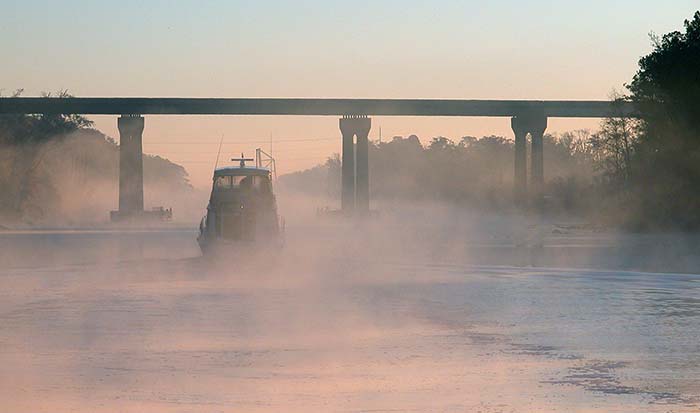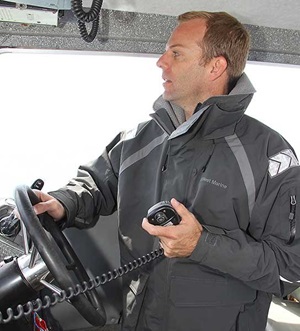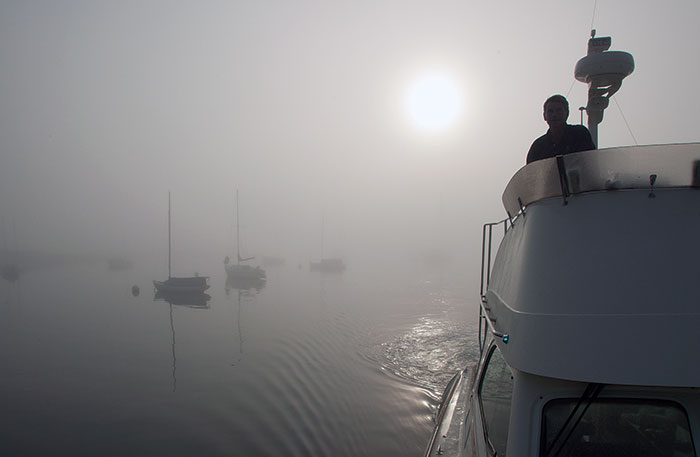Advertisement
Even with all the electronic eyes and ears on our modern vessels, fog at sea can bring on disorientation, panic, and danger. Here's how to get ready and deal with it.

Photo: Mel Neale
When you're boating in fog, your perception of the world around you changes dramatically. Basic instincts don't work well, if at all.
Your normal sources of information about what's around you become virtually useless, and it's easy to grow confused and disoriented.
If you suspect fog may roll in, immediately turn on all relevant navigational instruments and note your compass course. When fog descends, immediately turn on all relevant navigational instruments. Radar and other hardware require warming up, perhaps for up to three minutes — an eternity if you can't see and there's danger nearby. Turn on your navigation lights; verify the horn is working; have your bell ready, if you carry one; get out spotlights (they may help or hinder, but have them at hand); and ready safety gear.
Note your compass course and bearings to geographical features and dangers. These include boats, reef, shoals, and aids to navigation (ATON). Do this with the actual compass, and also use the chartplotter, radar, and paper charts. Program your chartplotter with appropriate waypoints and/or routes, if you haven't already done so. It may be appropriate to pick out a safe area and put in a "go to" route.
Everyone should wear life jackets outfitted with a strobe, whistle, and other appropriate safety equipment. You won't be seen if you go in the water.
If you're in restricted waters, stop if it's prudent. (More on this later.) If you're in open water with no known hazards, it's usually safe to proceed, slowing down to a speed suitable for the circumstances, which usually means moving just enough to maintain steerage and control. The faster you're running, the quicker you must react to dangers that may present themselves with little advance warning. Begin sound signals as required by the U.S. Coast Guard Navigation Rules. See Rules 35, 34, and 2 as well as all others applicable to the situation.
The Watch
Set up extra watch. Usually this involves having all available on deck and assigned a watch task. If only two people are aboard, obviously one must be at the helm. To the extent that this person can watch visually, he or she should, but often visibility is limited to just a few feet and that person is also concentrating on the radar, chartplotter, and other instruments.
The person on watch frequently stands outside the steering station, peering into the fog and listening. Visibility, such as it is, should be better outside without the misting of the windshield or windscreen. And the swirling mist makes phantom shapes that are confusing. But occasionally, as you become accustomed to fog, you'll begin to pick out temporary density changes, which may indicate a target.
The outside watchperson should have a good set of binoculars but may not use them unless they're needed to clarify an anomaly because the lenses quickly mist up in fog. When you do peer into the fog with binoculars, be prepared to see anything from nothing to shapes that are very different from what you saw with your eyes. Also look for other clues: Wakes, for example, can indicate that a boat has recently passed.
It's also easier to hear outside. Any unusual sound should be considered suspect and should be checked out. In fog, the tiniest noise from your boat may distort or drown out the slightest noise from another boat. Sometimes it helps to temporarily kill the engine to better hear, but I'm normally reluctant to do this because I never know when I might need to quickly get out of the way of something. However, circumstances may call for this.
Fog not only muffles sounds; it plays tricks with them. It's often very difficult to know the direction of a sound. If you hear something, try to get a general idea of direction, alert the helm, and use radar and/or the chartplotter and charts to sort it out. Use fog sound signals. You may also need to call out on the VHF. Examples of sounds that you may hear include fog signals from other vessels, engines, tidal rips, breaking waves, wakes, land sounds such as sirens or traffic, signals on ATON, and even people talking.
It may be best for the lookout to be at or near the bow. You can see things sooner, and there is less hindrance from your engine noise. With sufficient crew, a lookout on the stern is also helpful, watching for overtaking vessels and acting as a double check on the bow lookout. Be sensitive to smells. We've smelled land, rocks, other boats (from their exhaust or moldy hulls), commercial fishing boats, buoys, and even tidal changes.
Reach Out To The Other Boaters Out There

Not only do you want to know what's out there; you also want all other boats to know you're there and where you're going. The Rules of the Road call for specific fog signals. But if it's prudent to do so, skippers will very briefly pause occasionally to be sure that their signal isn't drowning out another signal.
Remember, sound signals may not be heard in an enclosed wheelhouse with the noise of a motor in the background. Also, it may be difficult to determine the direction of a sound source in the fog.
Someone should be assigned to monitor and respond to VHF radio broadcasts. ("Yes, I'm the target approximately a quarter-mile to the east of Red 14 in the Indian River, proceeding at 3 knots on a course of 180 degrees, and I do have you on my radar.") It's better to have someone other than the person at the helm, who may be very busy.
It may also be helpful to call out a brief "sécurité" on the VHF radio giving your position, course, vessel name, and type. But if there are too many boats around you, this may become counterproductive if everyone is calling. Use your best judgment as to when to transmit. ALWAYS listen for other calls and respond if prudent.
When you give your position, it may be appropriate to give not only your latitude and longitude but also your position relative to a known ATON or landmark. Many skippers are so busy in fog that by the time they determine the location of a lat/long position, it may be too late. Some commercial vessels and large yachts with sophisticated equipment can tell quickly what your lat/long means to them and will probably know your location, speed, and bearing. But you won't know whether the other vessel is so equipped. Obviously, an automatic identification system (AIS) can be invaluable in a fog situation. However, there will still be vessels, as well as other objects, not equipped with AIS.
The Helm
If there are enough crew, assign a person to help the helmsperson. Steering to a radar screen, chartplotter, computer screen, or compass when you can't see is difficult unless you're experienced. Practice in good weather to get the feel for it when you're socked in. This will help to prepare you for the emotional jolt you'll experience when you're behind the wheel in the soup.

Photo: Onne van der Wal
In good weather and open water, with at least one other competent person aboard to keep watch for other boats and dangers, force yourself to steer toward and away from a radar image without letting yourself look at anything but the radar. Do the same for a target on a chartplotter or the combined screen overlay. If your target is a far distance off, this may not be a problem, but if it's at close range, it may be very difficult. If the target is moving, or if there are other targets around, it's even more challenging. Steering blind can add an element of panic.
Tip
Radars and chartplotters don't have an instant real-time acquisition and refresh rate. It isn't going to be as close to real time as seeing that target with your eyes. Complicating the situation, you'll probably be moving much slower than usual, so your boat will respond more sluggishly. As you try to compensate for a new image on the screen, which has suddenly jumped off to the side, your boat isn't going to react like you expect when you turn the wheel, and this can cause a tendency to overshoot or undershoot.
I steer best if I quickly look at the compass and get a bearing when I'm concerned about a target on the radar or a bearing on the chartplotter. This works for me because I've been steering compass courses for more than 60 years. Other tactics might work better for you. Learn to use and interpret the displays on your electronics intuitively. You won't have time to figure it out when you're fogged in.
Your radar doesn't necessarily show you everything out there. It may miss some targets completely, especially if it isn't adjusted correctly for the circumstances (rain, sea clutter, mist). Some radars automatically adjust to some interference, but never rely on this function completely. Learn to distinguish targets. A blob looks like a blob, but a big steel ship, for example, will generally create a much larger blob than a buoy.
Disappearing and reappearing blobs are common. Sometimes it's because of a wave, an echo, or some other anomaly. Sometimes it's because of a small boat or obstruction. I've even picked up a flock of geese in V formation — even when the set was properly tuned. Become familiar with how your set reacts to different phenomena. Your boat may create radar reflections, particularly if there's a mast or other structure behind the antenna.
Learn how to determine whether a target you see on radar is closing with you. This is relatively easy when you're also using your eyes with good visibility. But in the fog (or at night), it can be quite difficult unless you understand your radar and how to use it, including collision prediction. Depending on your boat, you may want to have a radar reflector up so other radar-equipped boats can see you.
Fog will probably happen to you sooner or later. Plan now, prepare now. You'll be glad you did when your world disappears from view.
Nobody Move, Nobody Gets Hurt?
Often, when caught in fog in rivers or other inland waters, there's a place to pull out of the channel and drop the hook. Your chartplotter and depth finder can be helpful. But consider the safety issues. For example, while being followed, don't stop without giving notice to the following boat and then receiving its agreement. And anchoring just to the side of the channel can be dangerous, as other boats may be traveling outside the channel. It's not unusual for shallower-draft vessels to deliberately proceed outside the channel during fog in order to avoid larger vessels.
We usually prefer to anchor with a fleet of boats (if there's room to safely do so), well positioned out of the channel. With many boats clustered together, we know there's probably a more conspicuous radar target. But if something does come your way, it'll be difficult to move quickly, if needed.
You may want to anchor in the vicinity of an ATON; you'll know where you are and can tell other boats. But you should be well out of the channel in a place where the water is deep enough and there are no obstructions.
Anchor sufficiently away from the ATON so as to not present a confusing target to other traffic proceeding by radar. Anchoring too close can confuse others about the location of the ATON and can lead them to think that they're seeing an echo of the ATON target and thus disregard the "echo" that is actually your boat. Continue to monitor VHF and be prepared to tell other vessels your location.
Which VHF Channel?
The FCC confused communications some time ago, in my opinion, by asking pleasure boats to use Channel 9 for calling in order to relieve congestion on Channel 16, rather than actively prosecuting the people abusing 16. Channel 16 is the hailing and distress channel. Most commercial traffic monitors that frequency. Channel 13 is the bridge-to-bridge frequency, and most commercial traffic also stands by there. This is important to know when you're in fog.
When we call out a sécurité, we call on 16 and also on 13 because we feel these are the most relevant channels. We also monitor both frequencies. Monitoring 13 often gives insight into what's going on because you can hear commercial traffic talking about what they're doing to handle the situation. Sometimes two tugs talking a few miles away first alerts us to an actual fog bank. We don't rely on scanners for monitoring multiple VHF channels because these sometimes miss all or parts of transmissions. Instead, we have two VHF sets at the helm.
When we transmit, we state our frequency so that a responding vessel knows which frequency to use to respond. If you stand by on VHF 9 to the exclusion of the other two, you may miss important transmissions. Channel 13 transmits only on 1 watt, by default, on most sets, but better sets have a temporary manual override. Only transmit if necessary.
